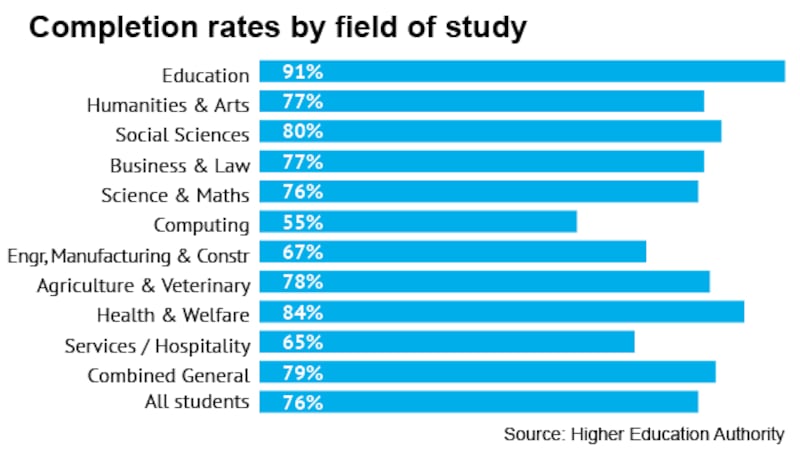A majority of students are dropping out of third-level computing and engineering courses with low CAO entry points, official figures show.
These high non-completion rates are a source of “huge concern” to education authorities, according to a major new study.
The findings are contained in a study by the Higher Education Authority (HEA) which has tracked a cohort of more than 34,000 students who started third-level courses in 2007/08 over a 10-year period.
Overall, the report shows the higher a student’s CAO points, the more likely they are to complete their course.
For example, a student with 505-550 points has a 6 per cent chance of dropping out of their course.
By contrast, a student with 205-250 points has a 51 per cent chance of not completing their course.
Female students are more likely to complete their courses and secure a higher grade in their final degrees.
However, male students in low points courses are at the highest risk of not completing their studies.

Students on education or teaching courses were least likely to drop out of their courses (9 per cent), followed by those in health and welfare courses such as medicine or nursing (16 per cent).
The highest non-completion rates were in courses such as computing (45 per cent), hospitality and services (35 per cent), and engineering/ construction (33 per cent).
Low points
When figures are broken down to low points courses at ordinary degree or higher certificate level, some computing and engineering courses have drop-out rates of more than 70 or 80 per cent.
For example, some engineering courses at IT Blanchardstown had drop-out rates of up to 89 per cent, while some computing courses had non-completion rates of 83 per cent.
Despite concerns over high drop-out rates in some areas, the study's authors say Ireland compares well internationally. Overall, more than four out of five students at higher level are completing honour degree courses.
This falls to three out of five completing ordinary degree or higher certificate courses.
Chief executive of the HEA Paul O’Toole said while findings were mostly positive, further consideration was needed to address some of the challenges identified.
“In particular, we need to look at non-completion rates by males in certain areas, and the higher education system is seeking ways to improve the outcomes for those students,” he said.
Dr Joseph Ryan of the Technological Universities Association said the capacity of students in maths was a clear factor in high non-completion rates in some computing and engineering courses.














